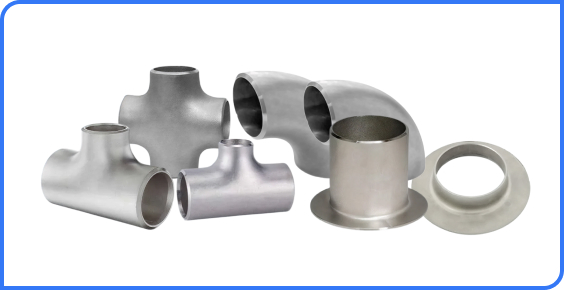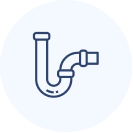Buttweld Fittings
What are Buttweld Fittings?
Buttweld Fittings are pipe connectors used to alter the direction, branch, or diameter of piping systems through a welded joint. Unlike threaded pipe fittings
or socket weld fittings, buttweld fittings are welded directly to pipes, offering a strong, permanent, and leak-proof connection suitable for high-pressure and high-temperature applications.
These fittings are available in a wide range of shapes and sizes, including elbows, tees, reducers, caps, and crosses, and are manufactured from carbon steel, stainless steel, alloy steel, and duplex grades.

Key Features

Leak-Proof
Jointing

Durable
Construction

High Pressure
Resistance

Wide
Compatibility

Corrosion
Resistant
Specifications
| Specification Category | Parameter / Feature | Details / Options |
|---|---|---|
| Size Range | Nominal Pipe Size (NPS) | ½” to 48” (DN15 – DN1200) |
| Pressure Ratings | Class 150, 300, 600, 900, 1500, 2500 | |
| PN Ratings | PN6, PN10, PN16, PN25, PN40, PN64 | |
| Fitting Types (Butt Weld) | Elbow | 45°, 90°, 180° (SR & LR) |
| Tee | Equal, Reducing | |
| Reducer | Concentric, Eccentric | |
| Cross | Equal, Reducing | |
| Cap | End Caps | |
| Long Stub End | MSS Type A, Type B | |
| Material Options | Stainless Steel | SS 304, SS 304L, SS 316, SS 316L, SS 321 |
| Carbon Steel | ASTM A234 WPB, ASTM A420 WPL6 | |
| Alloy / Superalloy | Alloy Steel (A234 WP1, WP5, WP9, WP11, WP22, WP91), Inconel 600/625/825 | |
| Duplex & Super Duplex | Duplex 2205, Super Duplex 2507 | |
| Other Materials | Monel 400/K500, Nickel 200/201, Titanium (Grade 2, Grade 5) | |
| Standards & Certifications | ASME / ANSI | ASME B16.9 (Butt Weld), ASME B16.28 (Short Radius Elbows & Returns) |
| ASTM | ASTM A234, ASTM A403, ASTM B366 | |
| European Standards | DIN 2605, DIN 2615, DIN 2616, EN 10253 | |
| Certifications | ISO 9001, PED 2014/68/EU, NACE MR0175, IBR Approved | |
| Design Features | Wall Thickness | As per ASME B36.10 (CS), ASME B36.19 (SS), customized options |
| Bend Radius (Elbows) | Short Radius (SR), Long Radius (LR) | |
| End Connections | Beveled Ends, Plain Ends | |
| Tolerance | As per ASME/ANSI standards | |
| Coating & Surface Finish | Anti-Corrosion Coating | Rust Preventive Oil, Black Oxide |
| Optional Coatings | Epoxy, PTFE, Polyurethane | |
| Surface Finish | Machined, Pickled, Polished, Passivated | |
| Testing & Inspection | Pressure Testing | Hydrostatic, Pneumatic |
| Non-Destructive Testing | Radiography (RT), Ultrasonic (UT), Magnetic Particle (MPI), Dye Penetrant (DPT) | |
| Destructive Testing | Tensile, Hardness, Impact |
Dimensions (ASME B16.9)
| Nominal Pipe Size (NPS) | Outside Diameter (OD) (mm) | Center-to-End (C) (mm) | Center-to-End (M) (mm) | Overall Length (L) (mm) | Wall Thickness (Std. Sch 40) (mm) | Approx. Weight (kg) |
|---|---|---|---|---|---|---|
| 1/2″ (15) | 21.3 | 25 | 25 | 38 | 2.77 | 0.20 |
| 3/4″ (20) | 26.7 | 29 | 29 | 38 | 2.87 | 0.30 |
| 1″ (25) | 33.4 | 38 | 38 | 48 | 3.38 | 0.45 |
| 1 1/2″ (40) | 48.3 | 57 | 57 | 76 | 3.68 | 1.00 |
| 2″ (50) | 60.3 | 64 | 64 | 89 | 3.91 | 1.90 |
| 2 1/2″ (65) | 73.0 | 76 | 76 | 102 | 5.16 | 3.00 |
| 3″ (80) | 88.9 | 86 | 86 | 114 | 5.49 | 4.60 |
| 4″ (100) | 114.3 | 105 | 105 | 152 | 6.02 | 8.00 |
| 5″ (125) | 141.3 | 124 | 124 | 190 | 6.55 | 12.50 |
| 6″ (150) | 168.3 | 143 | 143 | 229 | 7.11 | 18.00 |
| 8″ (200) | 219.1 | 178 | 178 | 305 | 8.18 | 32.00 |
| 10″ (250) | 273.0 | 216 | 216 | 381 | 9.27 | 52.00 |
| 12″ (300) | 323.9 | 254 | 254 | 457 | 9.53 | 75.00 |
| 14″ (350) | 355.6 | 279 | 279 | 533 | 9.53 | 100.00 |
| 16″ (400) | 406.4 | 305 | 305 | 610 | 9.53 | 130.00 |
| 18″ (450) | 457.2 | 343 | 343 | 686 | 9.53 | 165.00 |
| 20″ (500) | 508.0 | 381 | 381 | 762 | 9.53 | 210.00 |
| 24″ (600) | 610.0 | 432 | 432 | 914 | 9.53 | 310.00 |
Mechanical Properties
| Property | Value | Unit / Standard |
|---|---|---|
| Tensile Strength | 485 – 750 | MPa (varies with Carbon Steel, Stainless Steel 304/316, Alloy Steel) |
| Yield Strength | 170 – 450 | MPa |
| Hardness | 120 – 200 | HB (Brinell) |
| Elongation | ≥ 20 – 35 | % |
| Density | 7.8 – 8.0 | g/cm³ |
| Impact Toughness | ≥ 27 – 70 | J (Charpy, grade-dependent) |
| Modulus of Elasticity (E) | ~200 | GPa |
| Fatigue Strength | 200 – 400 | MPa |
| Corrosion Resistance | Good to Excellent (depending on SS / Alloy grade) | – |
| Thermal Conductivity | 15 – 50 | W/m·K |
| Coefficient of Thermal Expansion | 11 – 17 ×10⁻⁶ | /°C |
| Yield Ratio (YS/UTS) | 0.45 – 0.65 | – |
| Poisson’s Ratio | 0.27 – 0.30 | – |
| Brinell Hardness Range | 120 – 200 | HB |
| Surface Finish | Beveled Ends (as per ASME B16.25), Pickled & Passivated (for SS), Black / Anti-rust coated (for CS) | – |
| Operating Temperature Range | -46 to 600 | °C (material-dependent) |
| Pressure Rating | SCH 10 to SCH XXS (based on pipe thickness) | ASME B16.9 Standards |
Chemical Composition
| Element | SS 304 | SS 304L | SS 316 | SS 316L |
|---|---|---|---|---|
| Chromium (Cr) | 18.0 – 20.0 | 18.0 – 20.0 | 16.0 – 18.0 | 16.0 – 18.0 |
| Nickel (Ni) | 8.0 – 10.5 | 8.0 – 12.0 | 10.0 – 14.0 | 10.0 – 14.0 |
| Carbon (C) | ≤ 0.08 | ≤ 0.03 | ≤ 0.08 | ≤ 0.03 |
| Manganese (Mn) | ≤ 2.00 | ≤ 2.00 | ≤ 2.00 | ≤ 2.00 |
| Silicon (Si) | ≤ 1.00 | ≤ 1.00 | ≤ 1.00 | ≤ 1.00 |
| Phosphorus (P) | ≤ 0.045 | ≤ 0.045 | ≤ 0.045 | ≤ 0.045 |
| Sulfur (S) | ≤ 0.030 | ≤ 0.030 | ≤ 0.030 | ≤ 0.030 |
| Iron (Fe) | Balance | Balance | Balance | Balance |
| Molybdenum (Mo) | — | — | 2.0 – 3.0 | 2.0 – 3.0 |
Do you have questions?
Buttweld fittings provide superior strength, smoother internal flow, and better corrosion resistance due to the welded joint and lack of threading or gaps.
Yes. Seamless fittings are used for high-pressure/critical systems, while welded fittings are cost-effective for lower pressure applications.
Common methods include TIG, MIG, and arc welding, depending on project specs and pipe material.
Absolutely. We provide Mill Test Certificates (EN 10204 3.1/3.2) and third-party inspection reports (SGS, TUV, BV) on request.


